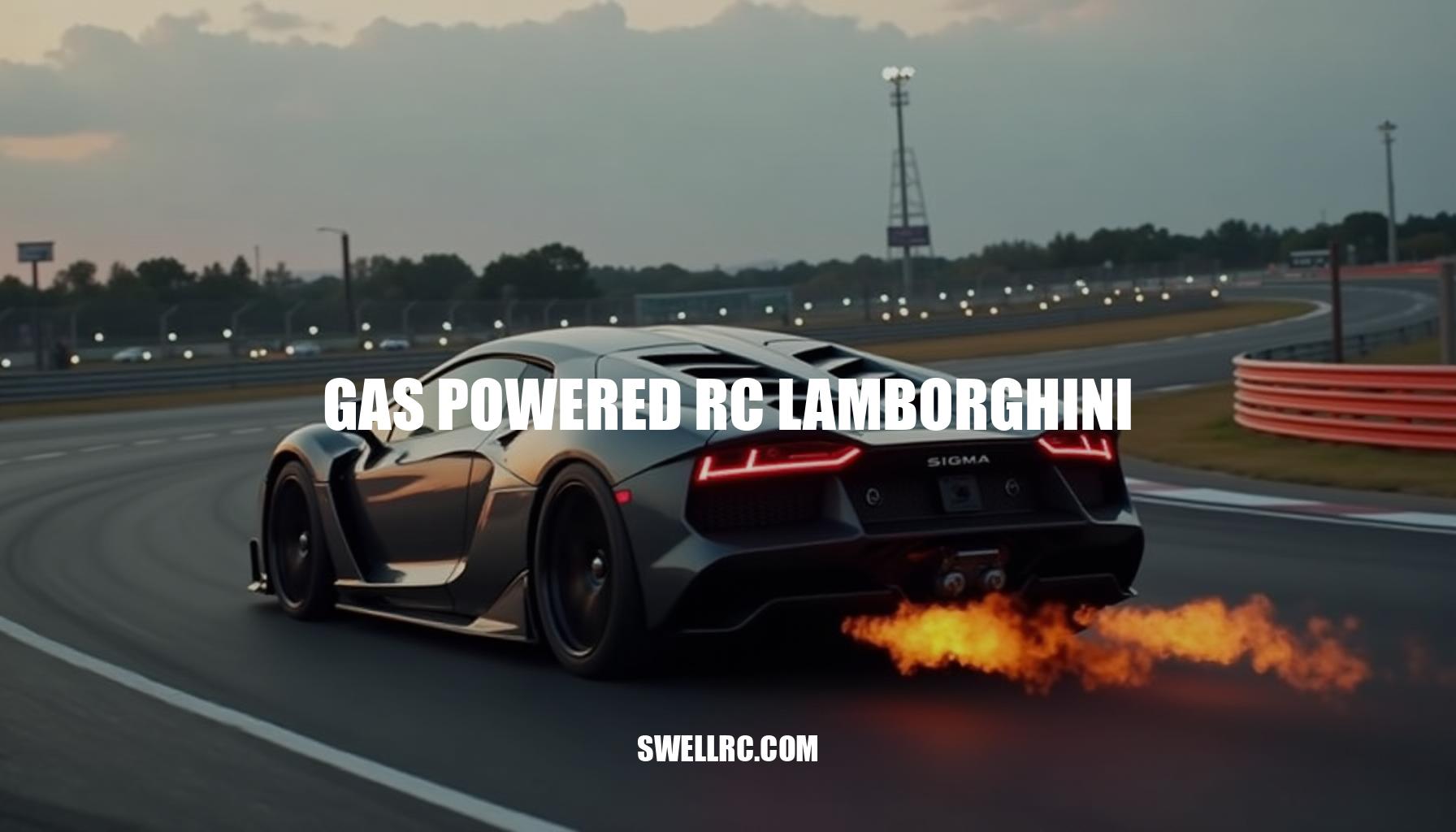Gas Powered RC Lamborghini: Unleashing Realism and Performance
The first time I squeezed the trigger on a gas powered RC Lamborghini, the tiny two-stroke engine barked to life, and the body hunkered down just like its full-size muse. The sound, the throttle response, and the way the aero shell cut through the air all felt more mechanical and visceral than any electric model I’d driven before. Over the years, I’ve chased RC car performance across many platforms, but nothing prepared me for the realism of a well-tuned gas powered RC supercar.
There’s a growing community of builders, tuners, and racers passionate about gas powered RC cars, appreciating not only their scale detail but also the ritual of fueling, warming up, and dialing-in the carburetor. If you’re curious about how gas powered RC Lamborghinis work, just how fast they can go, and what truly sets them apart from electric counterparts in the world of remote control Lamborghini models, you’re definitely in the right place to explore the thrilling realm of RC hobby racing.
What makes a gas powered RC Lamborghini so special?
Exploring the gas powered RC supercar segment reveals a profoundly different experience compared to electric alternatives. These engines boast a torque-rich feel, pulling hard and sustaining that power through longer runs. This mechanical energy translates into authentic sound and sensation that closely mirrors a mini supercar—a factor that aficionados of remote control Lamborghini models especially appreciate.
Additionally, the larger 1/5 scale RC models offer ample space for serious suspension setups, enhanced brakes, and aerodynamic tuning, elevating overall RC car performance.
When considering realism vs maintenance, gas-powered rigs offer richer realism with their engine notes, shifting feel, and exhaust sounds. However, this comes at the cost of increased upkeep, including carburetor tuning, clutch adjustments, and after-run care. On the other hand, electric models provide cleaner, quieter operation with less frequent maintenance, albeit with shorter runtimes and slightly different speed profiles.
| Aspect | Electric RC | Gas RC |
|---|---|---|
| Speed | 40–70 mph (bursty) | 35–80+ mph (sustained) |
| Runtime | 15–25 min/pack | 30–45+ min/tank |
| Realism | Quiet/clean | Engine note, shifting feel, exhaust |
| Maintenance | Low | Moderate (carb, clutch, after-run) |
Many of these gas-powered chassis and bodies borrow design cues directly from Sant’Agata’s iconic supercars, capturing sharp beltlines and aggressive stance that make remote control Lamborghini builds stand out on the track. To fully understand where a Lamborghini-bodied setup fits, it’s wise to start with the broader landscape of gas-powered RC cars before honing in on the high-performance, supercar-style on-road models. Learn more and explore options at Swell RC Gas-Powered Models.
Behind the power—how the engine redefines RC speed
Most gas powered RC Lamborghinis run 23 36cc two-stroke gasoline engines with a 2T oil mix, centrifugal clutch, and high-torque delivery ideal for heavier 1/5-scale bodies. With proper gearing and a clean tune, they�27ll rip in every RC Lamborghini speed test. I�27ve seen reliable top speeds in the 45 65 mph range, and higher with tall gearing and aero-friendly shells.
After successfully tuning a RC Lamborghini for speed by adjusting the carburetor�27s high-speed needle from 1.5 to about 1.25 turns, I picked up cleaner throttle response and a few extra mph without overheating, leveraging quality RC car fuel engines and high-performance RC transmissions.
If you�27re comparing platform options or hunting down the fastest gas RC car, it helps to scan brand ecosystems like Traxxas gas-powered RC cars and benchmark what�27s possible against records and builds featured near fastest gas RC car in the world.
| Model Type | Typical Top-Speed Range (mph) |
|---|---|
| 1/10 on-road electric | 40 70 |
| 1/8 nitro on-road | 45 75 |
| 1/5 gas Lamborghini-style on-road | 45 80+ (build-dependent) |
| Drag-optimized gas builds | 80 100+ (expert) |
Before running your high-performance RC setup, follow this safety and efficiency checklist to ensure reliability: verify failsafe and kill-switch function, keep fuel fresh, check clutch bell temperatures, and inspect the air filter every run. Proper maintenance combined with expert tuning maximizes speed and longevity of your RC Lamborghini build.
RC engineering masterpieces—scale, design, and customization
The magic happens at 1/5 scale RC models: longer wheelbases for stability, wide tracks for grip, and big aero surfaces that actually work. If you want to chase outright velocity, compare your goals with benchmarks from fastest 1/5 scale gas RC cars. Some builders cross-shop aerodynamic philosophies from single-seater bodies (see gas powered F1 RC cars) or even adapt rugged parts know-how from platforms akin to gas powered RC truck kits.
Popular RC customization tips include:
- Suspension tuning—springs, oil, sway bars for enhanced handling
- Exhaust and pipe swaps for powerband shaping and performance optimization
- Lightened flywheels and clutch springs to sharpen throttle response
- Brake pad compounds tailored for precise stopping power
- Foam GT tires versus belted rubber for grip and durability balance
- Custom paint jobs protected by clear films, combining aesthetic appeal with resilience
These modifications, combined with meticulous aerodynamic detailing and high-quality high-performance RC transmissions, elevate your gas powered RC supercar to new competitive levels. Moreover, the hobby also embraces rarity and luxury editions—high-detail shells, billet hardware, and bespoke builds—that can creep toward the price territory showcased at most expensive RC cars.
Comparing the thrill—cars vs planes vs helicopters
Driving gas powered RC cars like a Lamborghini on smooth asphalt emphasizes precision through lines, braking points, and delicate throttle modulation. This experience offers a very visual and visceral connection to the RC hobby racing scene, where performance focus often revolves around mastering grip and handling. In contrast, hot gas RC planes trade lateral grip for exhilarating skyborne speed and careful energy management.
Exploring different options and flying styles can be enlightening—see more at Swell RC’s guide to gas powered RC planes.
Helicopters introduce another dimension, leaning into 3D agility and requiring precise collective control. If you favor dynamic maneuvering and control in all axes, browsing impressions and setups of gas powered RC helicopters is worthwhile: Swell RC Helicopter Reviews.
Each platform delivers adrenaline in unique ways. Below is a quick RC ecosystem comparison summarizing the core differences between cars, planes, and helicopters based on realism vs agility and performance focus:
| RC Platform | Experience | Performance Focus | Key Appeal |
|---|---|---|---|
| Gas Powered RC Cars | Ground-level realism with scale detail | Handling, braking, throttle control | Realistic racing feel and tactile driving |
| Gas Powered RC Planes | High-speed flight and energy management | Speed, aerodynamic efficiency | Adrenaline from skyborne speed |
| Gas Powered RC Helicopters | 3D agility with multi-axis control | Precision collective and cyclic control | Dynamic flight and complex maneuvers |
Personally, I rotate among these platforms to satisfy a full-spectrum RC fix, enjoying the varied adrenaline rushes—from the tactile grip of RC cars to the boundless speed of planes and the intricate control of helicopters. This balance perfectly illustrates the richness of the RC ecosystem.
Owning one—tips, maintenance, and where to begin
When diving into the exciting world of gas powered RC cars, it’s essential to start by setting a clear budget and choosing your scale, usually around 1/5 for the best blend of realism and stability. Selecting a proven on-road gas chassis compatible with a Lamborghini shell simplifies RC customization tips and ensures solid performance. For a quick shortlist and inspiration, I recommend visiting curated RC Lambo picks at Swell RC.
To optimize your experience, begin with a first-run setup that includes installing a reliable failsafe system, verifying radio range to avoid interruptions, gently heat-cycling the engine, and carefully tuning the idle and low-speed needles for clean, responsive launches. Incorporating routine care is vital; always wipe down your vehicle after each run, clean and re-oil the air filter regularly, inspect clutch shoes and bell for wear, retighten exhaust bolts, and store fuel in a sealed container to maintain freshness. From my own experiments with oil ratios, specifically 32:1 versus 40:1, using a quality synthetic 2T oil at 32:1 resulted in a smoother midrange and cooler engine temperatures, a valuable insight for tuning a RC Lamborghini for speed.
Here’s a quick checklist integrating essential maintenance tips for gas RC cars and practical steps for `RC hobby racing:`
- Pre-run checklist: Check tires for wear, ensure brakes are responsive, inspect linkages for looseness, verify your failsafe settings, and secure body mounts firmly.
- Post-run checklist: Clean and re-oil the air filter, tighten all fasteners, monitor engine temps, drain or seal fuel if storing the car long-term, and apply after-run oil to protect internal components.
By following these comprehensive steps integrating expert maintenance tips for gas RC cars, effective RC customization tips, and strategic tuning methods, enthusiasts can elevate their RC hobby racing experience and achieve faster, more reliable runs with their RC Lamborghini.
Conclusion: the ultimate fusion of art and adrenaline
A gas powered RC Lamborghini offers an unparalleled experience that brings realism and performance right to your fingertips. Unlike typical electric models, this remote control Lamborghini captures the essence of a full-sized supercar through its distinctive engine roar and dynamic stance. Delving into this niche truly sharpens your understanding of RC car performance, as it combines both mechanical skill and passion.
- Sound: The authentic bark of the gas engine enhances the immersive experience.
- Stance: A realistic chassis squat mimics the behavior of a true Lamborghini under acceleration.
- Tuning: Hands-on adjustments allow you to fine-tune your vehicle for peak RC hobby racing efficiency and speed.
If you’re excited by the idea of working with fuel, tools, and precise calibrations, a gas powered RC Lamborghini is the perfect gateway into advanced RC hobby racing. Feel the thrill of each pull-start, and experience first-hand the craftsmanship and dedication that elevate this hobby beyond mere play.
Frequently Asked Questions
- How do gas powered RC Lamborghinis compare to electric RC cars?
Gas offers longer runtime, deeper mechanical realism, and a visceral sound/feel. Electric is cleaner, quieter, and delivers instant torque with less maintenance. Top speed potential overlaps; gas shines in sustained pulls and scale immersion, while electric often wins for convenience. - What makes gas powered RC cars faster and more realistic?
Two-stroke torque, heavier 1/5-scale chassis with real aero, and mechanical drivetrains (clutch, gearing) create a life-like feel. They aren’t always faster than top-tier electrics, but the engine note, throttle dynamics, and weight transfer feel more like a miniature supercar. - How much does a gas powered RC Lamborghini cost?
Expect roughly $700–$2,500 for quality 1/5-scale setups, depending on chassis, engine, and body. Premium or custom builds with billet parts, performance pipes, and high-detail shells can exceed $3,000 and climb much higher. - Can I build a gas powered RC Lamborghini from a kit?
Yes. Many hobbyists start with a proven 1/5 on-road gas chassis and fit a Lamborghini-style body, then add gearing, tires, and suspension tuning. You’ll need basic tools and patience for body trimming, mount alignment, and engine/carb setup. - How do you tune a gas powered RC engine for max performance?
Warm the engine, set idle, then adjust the low-speed needle for crisp launches and the high-speed needle for peak rpm without lean surging. Verify clutch engagement, choose gearing for your track length, and use fresh fuel and a clean air filter. - What fuel type is best for gas powered RC vehicles?
Most 1/5 gas RC cars run pump gasoline mixed with quality 2-stroke oil at 25:1–40:1. Ethanol-free premium is ideal if available. Use consistent oil and ratio, and keep fuel fresh for reliable tuning. - What’s the most realistic gas powered RC car model?
High-detail 1/5-scale on-road cars with accurate Lamborghini shells, functional aero, quality brakes, and tuned pipes feel the most real. Look for solid drivetrains, predictable suspension, and a setup that balances top speed with stable handling.



